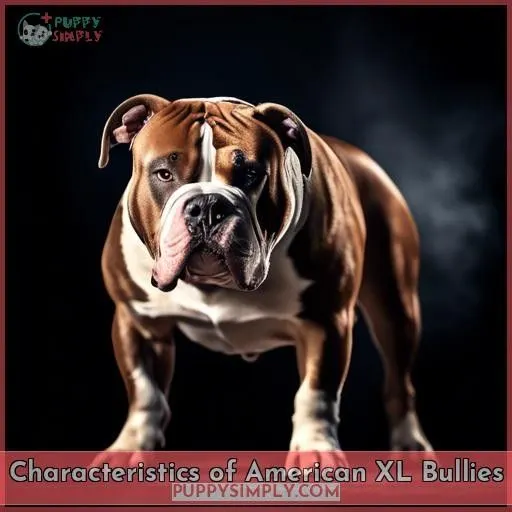This site is supported by our readers. We may earn a commission, at no cost to you, if you purchase through links.
The American XL Bully is a muscular, blocky-headed breed that can grow up to 20 inches tall. While their imposing appearance may concern some, XL Bullies are often gentle and loving companions when properly cared for.
Ownership of this breed is highly restricted in the UK due to breed-specific legislation. Owners must obtain an exemption certificate, which requires insurance, microchipping, and keeping the dog leashed and muzzled in public.
Despite these challenges, responsible ownership and proper training can help the XL Bully thrive. If you’re interested in learning more about this misunderstood breed, continue reading to discover their characteristics and how you can help a rescue XL Bully like Nuke.
Table Of Contents
- Key Takeaways
- What is an American XL Bully?
- Characteristics of American XL Bullies
- Restrictions on Ownership
- Insurance Requirements
- Breed-Specific Legislation
- Pit Bull Terrier
- How to Help a Rescue XL Bully Like Nuke
- Frequently Asked Questions (FAQs)
- What is the definition of an American XL Bully?
- How does the American XL Bully ban work in England and Wales?
- What are the requirements for exempt XL Bully owners in England and Wales?
- What are the penalties for breaking the American XL Bully ownership restrictions in Scotland?
- How does the American XL Bully ban affect the sale and transfer of ownership in Scotland?
- Conclusion
Key Takeaways
- The American XL Bully is a breed of dog known for its muscular body and blocky head, often leading to concerns about safety and legislation restricting ownership in the UK.
- Despite these restrictions, responsible ownership and proper training can help the XL Bully thrive as a gentle and loving companion.
- Ownership of an XL Bully in England and Wales requires an exemption certificate, which includes insurance, microchipping, and keeping the dog leashed and muzzled in public.
- Breed-specific legislation is a subject of ongoing debate, with some advocating for better training and understanding of the breed, while others support the legislation.
What is an American XL Bully?
American XL Bullies are a breed of dog that has been subject to much controversy and legislation, particularly in the UK. They’re the largest type of American Bully, known for their muscular bodies and blocky heads.
Despite their intimidating appearance, these dogs are often gentle and loving. However, their size and strength have led to concerns about safety, resulting in restrictions on ownership under the Dangerous Dogs Act 1991.
Advocacy groups argue for better training and understanding of the breed, while others support breed-specific legislation. The future of the American XL Bully remains uncertain, with ongoing debates about their role in society.
Characteristics of American XL Bullies
The American XL Bully is known for its massive, muscular build and blocky head. Male XLs can stand up to 20 inches tall at the shoulder, while females are slightly smaller, but all XLs must meet specific height and other physical requirements to be considered the breed.
Size and Weight
As an American XL Bully, these dogs are the largest type of American Bully. Males can reach a height of 20 inches at the shoulder, while females are slightly smaller. Their muscular bodies and blocky heads are characteristic of the breed.
American Bully genetics play a significant role in their health and temperament variation. Despite breed-specific bans, ethical breeding practices are essential for the well-being of these dogs. Temperament can vary, and the Dog Control Coalition advocates for breed-specific legislation to control dangerous dogs.
Physical Appearance
As we explore further into the traits of American XL Bullies, it’s crucial to grasp their physical attributes. These dogs stand out with their robust bodies and square heads. Health considerations, breed specifications, and genetic diversity influence variations in appearance. Training hurdles may surface due to size and strength, but with appropriate direction, these dogs can evolve into affectionate companions.
Temperament
Departing from their imposing physique, American XL Bullies frequently challenge breed preconceptions through effective puppy training and socialization techniques. Conscientious breeding and temperament evaluations expose an inclination toward dominance, demonstrating a breed competent in both authority and companionship, not merely physical strength.
Restrictions on Ownership
Owning an American XL Bully in England and Wales is now highly restricted under the Dangerous Dogs Act 1991. To legally possess an XL Bully, owners must obtain an exemption certificate by meeting specific requirements like purchasing insurance, microchipping the dog, and keeping them leashed and muzzled in public.
Illegal Activities
Owning an American XL Bully in England and Wales isn’t a simple task. It’s illegal to breed, sell, abandon, or give away these dogs. Criminal offenses include owning one without an exemption certificate. This has led to a surge in demand for exemptions, with over 61,000 applications before the deadline.
The police can seize unregistered dogs, and owners face fines and criminal records. Despite these restrictions, illegal breeding, black market sales, dogfighting, and puppy mills continue to thrive, fueled by the demand for these dogs.
Exemption Certificates
If you’re an American XL Bully owner in England and Wales, you’ll need an exemption certificate to legally own your dog. This certificate, which costs £92.40, comes with conditions such as purchasing insurance, microchipping, and keeping your dog on a lead and muzzled in public.
Enforcement of these regulations is strict, with police able to seize unregistered dogs and owners facing fines and criminal records. The public perception of these breeds is often negative, leading to breed discrimination.
However, responsible owners are working to change this, focusing on education and owner responsibility.
Insurance Requirements
If you own an American XL Bully in England and Wales, you’ll need to purchase insurance, microchip your dog, and keep it muzzled and on a lead when in public. Meeting these requirements is essential to obtain an exemption certificate and legally own this banned breed.
Microchipping
As part of the insurance requirements for exempt XL Bully owners in England and Wales, microchipping is essential. This involves implanting a small device under the dog’s skin, which stores vital information such as the owner’s contact details. The cost of microchipping can vary, but it’s a small price to pay for peace of mind and the safety of your pet.
The benefits of microchipping are numerous: it guarantees your dog can be easily identified and reunited with you if they ever get lost or stolen. Additionally, it’s a legal requirement for all dogs in the UK, so it’s important to comply with this regulation.
If you’re considering adopting an XL Bully, be prepared to microchip your new companion.
Secure Housing
As a responsible American XL Bully owner, you understand the significance of secure housing. To meet insurance obligations, you must make sure your dog is microchipped and appropriately housed. This section will explore the details of ownership concerns, housing rules, and safety measures, assisting you in navigating the challenges of responsible breeding and microchipping compliance.
Public Restrictions
Traversing the labyrinth of public restraints goes beyond evading legal entanglements; it necessitates promoting ethical breeding, guaranteeing compassionate treatment, and protecting societal well-being. Envision it as a precarious balance beam above the abyss of irresponsible ownership, with legal consequences lurking beneath.
Breed-Specific Legislation
Are breed-specific bans on American XL Bullies truly effective in enhancing public safety? Many experts argue that targeted legislation may not address the root causes of dog attacks and that alternative approaches focusing on responsible ownership and all-encompassing pet laws could be more impactful.
Effectiveness
Breed stigma can be a potent force, but it’s vital to recall that breed-specific legislation isn’t an infallible remedy. Public awareness and responsible pet ownership are fundamental to alleviating potential hazards. Advocacy organizations and research projects can assist in reshaping the narrative, promoting a more nuanced comprehension of breeds like the American XL Bully.
Alternatives
Instead of breed-specific legislation, consider focusing on responsible dog ownership and education. Encourage adoption, exemptions, and rehoming to improve breed welfare.
Pit Bull Terrier
The origins and public perception of pit bull terriers are deeply intertwined with the controversy surrounding the American XL Bully. Though these dogs were once favored as loyal family companions, they’ve since become the focus of heated debate due to concerns over their potential for aggression.
History of Ban
The history of the ban on American XL Bullies, also known as Pit Bull Terriers, dates back to the 1991 Dangerous Dogs Act in the UK. The Act was introduced to address the issue of dangerous dogs, which included the Pit Bull Terrier, by prohibiting their ownership, breeding, and sale. The ban was a result of a series of high-profile attacks involving the breed, with six out of ten fatal dog attacks in the UK involving an XL bully in 2022.
The ban has had significant impacts on breeders, who’ve been advised to stop mating their dogs ahead of the ban. It has also been a source of controversy, with pro-XL bully marches and campaigns arguing that the breed shouldn’t be judged solely based on its appearance and that responsible ownership is key to preventing attacks.
Enforcing the ban has presented challenges, as it requires the identification and seizure of unregistered dogs, with owners facing fines and criminal records if they fail to comply. To address these challenges, public education campaigns have been implemented to promote responsible dog ownership and the importance of neutering and microchipping dogs.
The effectiveness of breed-specific legislation in reducing dog attacks and deaths is a subject of ongoing debate, with some arguing that it isn’t a reliable predictor of aggressive behavior in dogs and that solutions should focus on promoting responsible pet ownership rather than banning breeds.
Despite the ban, the public perception of the breed remains mixed, with some viewing them as aggressive and dangerous, while others defend them as loving and loyal companions when properly trained and cared for.
Public Perception
The media depiction of American XL Bullies has fostered a breed caricature that frequently elicits an impassioned reaction from the public. This can adversely affect public well-being, as conscientious ownership is frequently neglected.
It’s imperative to bear in mind that legislation targeting specific breeds isn’t the sole remedy for canine-related concerns. Instead, prioritizing education, instruction, and accountable ownership can contribute to the creation of a safer and more empathetic setting for all canines, encompassing American XL Bullies.
How to Help a Rescue XL Bully Like Nuke
If you’re looking to help a rescue XL Bully like Nuke, there are several ways you can do so. Here are five actions you can take:
- Donate to a fundraising campaign: Nuke’s medical expenses are high, and his family may not be able to afford them. You can donate any amount to help cover these costs.
- Share Nuke’s story: By sharing Nuke’s story, you can help raise awareness about his situation and encourage others to donate or offer support.
- Provide foster care: If you have the resources and ability, you can offer to foster Nuke temporarily while he recovers from his medical issues.
- Offer emotional support: Rescue dogs like Nuke often face challenges and can benefit from the support of a caring community. Offer words of encouragement and understanding.
- Advocate for breed-specific legislation reform: If you’re passionate about the issue, you can use your voice to advocate for changes in laws that restrict ownership of certain breeds, like the American XL Bully. This can help guarantee that dogs like Nuke have a better chance at finding loving homes in the future.
Frequently Asked Questions (FAQs)
What is the definition of an American XL Bully?
The American XL Bully is the heavyweight champion of the canine world, a muscular marvel boasting a blocky head and towering stature – a true powerhouse that demands respect. Embrace its commanding presence and you’ll uncover a loyal, loving companion.
How does the American XL Bully ban work in England and Wales?
In England and Wales, owning an XL Bully dog is restricted – you’ll need an exemption certificate, insurance, microchipping, and secure housing. Break the rules, and you could face fines or even a criminal record.
What are the requirements for exempt XL Bully owners in England and Wales?
To own an exempt XL Bully in England and Wales, you must purchase insurance, microchip the dog, pay a £40 fee, secure proper housing, and keep the dog leashed and muzzled in public. This strict criteria aims to mitigate the breed’s known dangers.
What are the penalties for breaking the American XL Bully ownership restrictions in Scotland?
If you own an American XL Bully in Scotland without the proper exemption, you’re in for a ruff time – the paw-nalty is no joke! Face hefty fines and the dogcatcher could haul your four-legged friend away. Better bone up on those requirements, stat!
How does the American XL Bully ban affect the sale and transfer of ownership in Scotland?
In Scotland, it’s illegal to abandon, rehome, sell, buy, or transfer ownership of an American XL Bully. Owners must secure an exemption certificate by July 2024 to legally possess these dogs, or face penalties.
Conclusion
Envisioning a future where the muscular American XL Bully finds its rightful place as a cherished companion, responsible ownership and evidence-based policies can reveal the breed’s true potential.
By embracing the XL Bully with open arms and challenging misconceptions, you can help this misunderstood breed thrive and dispel the notion of XL Bullies as dangerous outcasts.
Through compassionate understanding, the XL Bully can emerge as the loyal, affectionate partner it was destined to be.














